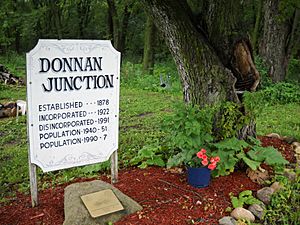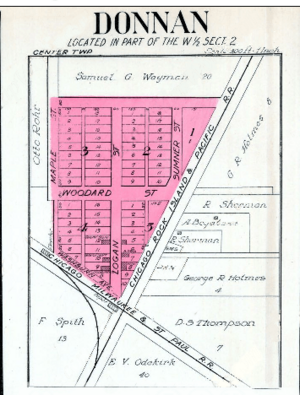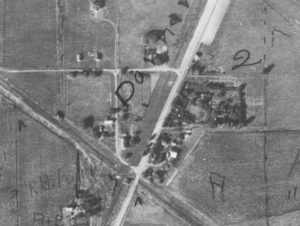Donnan, Iowa facts for kids
Quick facts for kids
Donnan, Iowa
|
|
|---|---|

Site of Donnan
|
|
| Country | United States |
| State | Iowa |
| County | Fayette |
| Platted | 1878 |
| Area | |
| • Total | 1.00 sq mi (2.59 km2) |
| Population
(1990)
|
|
| • Total | 7 |
| • Density | 7.0/sq mi (2.70/km2) |
| Time zone | UTC-6 (Central (CST)) |
| • Summer (DST) | UTC-5 (CDT) |
| ZIP codes |
52139
|
| Area code(s) | 319 |
Donnan was once a small town in Iowa, a state in the United States. It was located in central Fayette County. For many years, Donnan was known as Iowa's smallest official city. Over time, fewer and fewer people lived there. By 1990, only 7 people remained. These last residents decided to close down the city government. Donnan officially stopped being a city in early 1991. Today, it is considered a ghost town.
Contents
The Story of Donnan
How Donnan Started
Donnan got its first post office on July 10, 1874. The town was officially planned out in 1878. It was first called Donnan Junction. This name came from its location where two major railroads met: the Chicago, Milwaukee, St. Paul and Pacific and the Chicago, Rock Island and Pacific railroads. The town was named after William G. Donnan. He was a politician who served in the United States House of Representatives from 1871 to 1875.
The town's plan showed Donnan divided into five sections, called blocks. Blocks 2 and 3 had 18 smaller plots each. Blocks 1, 4, and 5 were smaller because the railroad tracks ran through them. Donnan had three streets that ran north to south: Maple, Logan, and Sumner. The streets running east to west were Woodard Street and Washburn Avenue. By 1916, only six houses had been built. All of these were on Logan Street. Some farmhouses were also built facing the Rock Island railroad tracks.
Becoming an Official City
Donnan became an official city in 1922. This was done so a school could be built there. About 1 square mile (2.59 square kilometers) of land was included in the city limits. This helped the area meet the state's rule of needing at least 25 people to be a city.
By the 1930s, the town had made some improvements. A new road was built next to the Rock Island railroad. This road was called New Donnan Road. It became the town's main street.
Besides the post office and railroad station, Donnan also had many businesses. These included:
- a meeting hall
- a pool hall
- stock yards (for farm animals)
- a restaurant
- a company that sold farm equipment
- a hardware store
- a grain elevator (for storing grain)
- a stable for horses
- a blacksmith shop
- a three-story hotel
Even with all these businesses and its great location by two railroads, Donnan never had many residents. The most people who ever lived in Donnan was about fifty, in the 1940s.
In 1954, Donnan was the smallest recognized city in Iowa. The post office served 12 families, which was about 50 residents, and the school. The United States Postal Service decided to close the Donnan post office that year. But the residents protested, and the closure was stopped in February 1955. However, Donnan did lose its school in 1957. The hotel had been moved to Sumner in 1947 and changed into apartments.
Lynn J. Webb was Donnan's postmaster until he passed away in 1955. He also ran a filling station and general store from the same building. Gertrude Menuey became postmaster from 1955 to the 1970s. Eileen Lee was the postmaster during the 1980s.
A. L. Begalske was the mayor of Donnan until he died in 1955. Matthew Porter was then chosen as mayor. He served for the next 35 years. Ruth Holmes was the town clerk, and Margaret Gage was the treasurer.
The Town Shrinks
Over time, Donnan's small population kept getting smaller. By 1970, fewer than 25 people lived there. In 1972, only 18 residents remained. All businesses except the post office had closed by the early 1970s. County road W-25, a paved highway, was built in the early 1970s. This new road went from nearby Randalia to the county seat at West Union. It bypassed Donnan's main street, New Donnan Road.
By 1977, Donnan had only a few buildings left. These included an old grain elevator, an unused railroad station, three farms, four occupied houses, and some empty buildings. The Rock Island Railroad tracks in Donnan were removed in 1977. By 1978, the town's population had dropped to just 13 people. That year, the residents celebrated the city's 100th anniversary.
Donnan's few remaining residents tried hard to keep their post office open. But by 1982, postal officials decided to close it. When the post office closed on July 23, 1982, the town's population was listed as ten. Mayor Porter said in 1988 that residents resisted the closing because they loved Donnan and did not want it to disappear.
In 1990, the last seven residents made national news. They sadly voted to officially close down their city. This ended Donnan's status as a recognized city. At the meeting, Matt Porter, who had been mayor for 35 years, said, "Three of us are in our 70s and sooner or later it's got to come. There's no one else to carry on." Donnan stopped existing as a city in March 1991. The final vote was 6 to 1 in favor of closing the city.
A monument on New Donnan Road now honors the empty community. Donnan is just two miles (3 km) north of its almost empty neighbor, Randalia, which has a population of 68. In October 2007, Randalia also lost its post office, after losing its school and general store. Matthew Porter, Donnan's last mayor, passed away in a fire at his home in Donnan in 2009.
Images for kids








